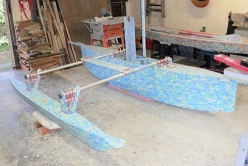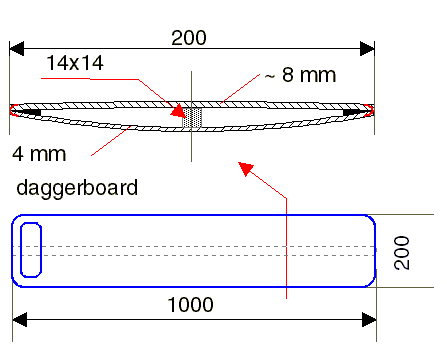
10' Class Proa
Thoughts about a cheap and simple to build proa for the 10' class. The main hull (Vaka) has flat bottom like a dory to support the lift of the crab claw sail during high speed. The body of the main hull is very wide to get the necessary buoyancy for boat and skipper. The behavior will be a little bit like a thick surfboard. Nevertheless is the seat for the sailor comfortable by the little cockpit for his feet. The outrigger carries only about 30-40 kg on his leverarm until it submersed. The whole displacement should be at 130-140 kg. The prismatic coefficient is 0,65.
The sail area with about 6,0 square meter corresponds nearly to 8-9 sqm of a classic bermuda rig. The Crab Claw is running on a rail which is fixed on both bow sprits and the beams. Alternative a Dierking/Gibbons rig is possible in the same way it is used at my 5m design P5. The Crab Claw may have advantages in wind beam reach, the Gibbons may be better close to the wind and have an easier handling during shunting. For all beginners: animated example of shunting.


P3: Gibbons/Dierking with 6,0 sqm
P3: Crab Claw with 6,0 sqm
In the following I offer a few drawings for all interested people which are crazy enough to build such a boat to take part in the 10' class regattas. Be shure that nothing is perfect and all measurements will be handled with care. In every case a lot of creativity in detail are required - please have a look at the comments at the end of the page (click on thumbnail to enlarge plans):
Cutplan - 2-3 sheets of playwood
Vaka - main hull
Ama - Outrigger
Top view
Daggerboard
Mast support variants
Bowsprit variants
Some comments for building the P3
- To build the Vaka start with cut out both hull sides (4 mm ply), all frames and the vertikal bow segements (8 mm ply).
- Glue the stringer on the upper and below edges of the hull sides, also build slots with small battens (1,5x1,5) to put the frames in. For gluing buy a starter kit of West Systems, SPS or annother company.
- Drill 4-5 holes in every bow and stich it together with copper wire
- Fill glue into the frame slots and press the four frames (6-8 mm ply) into it.
- Build the daggerboard case and put all reinforcements into the hull
- The beam holder are made from 8 mm ply or 2x4 mm. The drill is dependent from used beam. Proposal 50 mm aluminum tube. The beams are later fixed with girdles onto the beam holder (details see proa P5)
- Then measure the cockpit floor, cut and glue it into the hull.
- Put a piece plywood onto every deck and draw a line along the hulls edges, then cut and glue it onto the hull.
- Do the same with the bottom. To fix it after putting on the glue a tacker is very useful!
- Build in the bowsprit (like drawings show) and the Vaka is finished ;-)
- The Ama is build in traditional stich and glue. Cut out all pieces.
- Stich both hull sides and the small keel batten together.v
- Press the frames into the hull and glue all. Make the deck like before the Vakas deck.
- The rudder arrangement is simple. Ring bolts fixed in the decks reinforcements turns a little bit to allow the necessary movement. A rubber cord from deck to the rudder hold it on deck if not needed.
- The daggerboard is build from plywood (see drawing). Use a thicker and a thinner plate and you will get an assymmetric profile. The more flat side shows to lee.
- The rig is made by what you can easy get. Used or broken surf masts, bamboo, wooden poles etc.. Both variants, the Crab Claw and the Dierking/Gibbons need no shape. Both are made with straight cuts from Polytarp or fine sail cloth - and sooo efficient. The shrouds are simple ropes, at the Gibbons rig partial rubber cords (details see P5 rig).
- The mast mount must be flexible, because the mast bends itselfs while shunting. You can use a surf mast connector or cheaper - a piece of a strong hospipe which is glued into the mast and bolted into the mount.
I know the support is not dazzling (independent from my awful English), but the P3 is at last a experimental platform, which gives everybody a lot of freedom to realize things by himself. So don't worry be happy.
Othmar Karschulin
A nice building report
Othmar,
I found your plans for the 10' class proa and decided to build it this past summer. I have no experience in building boats before. Your instructions were very helpful in guiding me to a sailable boat.
I put together a galley of my experience with the build at https://imgur.com/a/dgiv0qE
Thank you for the boat plan. I learned a lot making the boat. This is the first of many sailboats I will build.
Thomas Murphy, Toronto, Canada
For further information to the big sister of the P3 see the description
of the 5 m proa P5
And at last will try to answer all the Questions you may have ...










 Othmar Karschulin
Othmar Karschulin